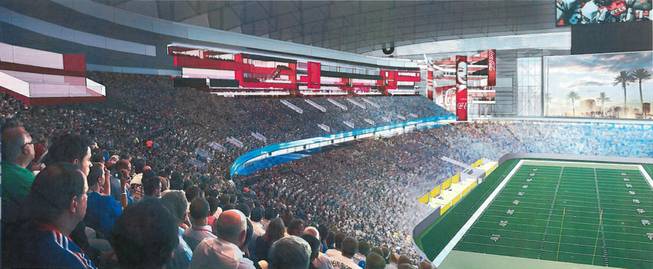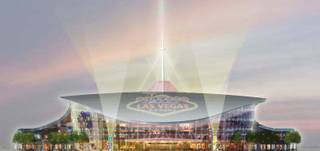
Courtesy
Artist rendering of the proposed UNLV Now project.
Sunday, July 15, 2012 | 2 a.m.
Related stories
- Race is on to build Las Vegas’ next big crowd pleaser
- Las Vegas’ history filled with failed stadium, arena projects
- Operators of existing venues say they welcome new competition
- Expert says look for final cost of new stadium or arena to exceed sticker price
- At a glance: Downtown arena
- Mayor hangs onto her NBA dream: If you build it, they will come
- At a glance: Las Vegas Arena Foundation
- At a glance: UNLV Now
- Rebels AD envisions transformed game days with on-campus stadium
- At Minnesota, new on-campus stadium proves a 'game-changer'
- UNLV president: On-campus stadium looking like a reality, could be filled with more events than UNLV football
- At a glance: Las Vegas National Sports Complex (Henderson)
When it comes to sports facilities, it’s easy to say you want a new one.
Whether it’s an arena, stadium or something in between, as soon as the latest and greatest venue opens in some other town, you begin to see the flaws in what you have and dream of the potential in something sparkling new.
That’s where Las Vegas currently sits, on the cusp of building a facility to potentially broaden the city’s horizons. And there are plenty of options from which to choose.
The primary projects in the works purport to put an arena on the Strip, downtown or in Henderson, and/or build a football stadium on the UNLV campus. These are more than just sports venues — for example, the UNLV Now mega-events center would include extensive retail shopping and on-campus living for students — but to many people, the field, court or stage is still the most important aspect.
Now that the easy part is over, it’s time for what is often the most difficult step in getting anything built: figuring out how to pay for it.
The projects have varying finance plans that would affect Las Vegas Valley residents in different ways.
The Las Vegas National Sports Complex in Henderson would be privately financed, developer Chris Milam said. But once constructed, plans call for the arena to be given to the city and leased back to the developers to operate, allowing the city to issue bonds and implement several financing tools. Among the options being considered: a standard property tax-increment area using increased revenue from rising property values to help pay for infrastructure such as sewers, roads and drains; a tourism improvement district to recapture some sales tax revenue; and a user-fee structure that would add to the cost of tickets, food, beverages and other goods sold at the stadium.
Both UNLV Now and the Las Vegas Arena Foundation (LVAF), which is seeking to build an arena just off the Strip, envision special tax districts that would surround the project location. UNLV Now developers are seeking a tax-increment finance district, which would require legislative approval. If the district were approved, the project would be exempt from paying property, sales and live entertainment taxes for an estimated 25 to 30 years. Developers could still collect those fees and keep the revenue to help pay off the project’s debt.
Similarly, the LVAF would seek approval to collect an additional sales tax on purchases made at businesses nearby, including many on and around the Strip.
Principals behind an arena for downtown Las Vegas haven’t declared their financing plans, though city officials say some public funding may be required.
Armed with that information, how do people determine which project best fits the city’s needs and which they’re most willing to pay for, both the explicit and implicit costs?
Take the Las Vegas Arena Foundation, for example.
The LVAF is a nonprofit created to put a stadium on the Strip, most likely on land donated by Caesars Entertainment. The clarity of that message has led to a Nevada Supreme Court case that continues to play out. Taxpayers for the Protection of Nevada Jobs, an opposition group backed by MGM Resorts International and Boyd Gaming, has claimed that voters were not made aware that approving the LVAF’s initiative petition may effectively end other arena projects in town.
The project also would impose a 0.9 percent sales tax at most businesses located within a three-mile radius around the arena, which would be located on Caesars’ 13-acre plot just east of Imperial Palace.
“We don’t think that’s right,” said Stacey Escalante of Nevadans Against Special Interest Taxation.
Escalante said NASIT doesn’t have a problem with Caesars or any other company building a privately funded arena, but it does balk at what it sees as a giant company with its hand out.“The radius, we all go down there. It’s not just tourists who go to buy stuff,” Escalante said. “If you go down there, you’re going to pay that.”
Bruce Woodbury, a longtime Clark County Commission member and chairman of the LVAF, said the proposal would put the bulk of the funding on tourists, with valley residents contributing on average $1 to $1.84 annually. Escalante countered that the city shouldn’t be trying to nickel and dime the very people needed to boost the local economy.
“We need the tourists to come,” Escalante said.
And although an additional 0.9 percent sales tax, or 90 cents for every $100 spent, isn’t likely to keep people off the Strip, the redirection of funds could have a negative impact on other Strip properties, opponents contend.
Beyond the new arena versus old arena battles that would be waged, there’s also the zero-sum game of substitution impact on the economy.
Mark Rosentraub, a professor of sport management at the University of Michigan, helped plan the Staples Center and LA Live project in Los Angeles and has written several books on the economics of sports facilities. UNLV reached out to Rosentraub to help with its project, which he said was a different animal than arena proposals and stadiums in other cities that are tied to professional teams.
“You’re looking at an economy that’s dependent and built around large mega-events,” Rosentraub said. “The fit of those within the hospitality sector is really a different variable. Las Vegas is an exception.”
A new arena creates a new option for people’s spending money, but unless it attracts events that bring in new visitors, then all it does is shift money from one place to another.
“That doesn’t create new wealth,” Rosentraub said.
UNLV’s proposed mega-events center would create new wealth, its proponents say. With an enclosed, 50,000-seat domed stadium, Las Vegas would be able to market itself to conventions and events that previously passed over the city.
If Las Vegas’ ultimate goal is to bring in an NBA or NHL team, the arena proposals are the way to go. Each states a goal of bringing in a professional team. The risk is probably higher — would games bring in crowds that aren’t already coming to town? — but there’s a perceived status upgrade with a pro team.
If Las Vegas’ ultimate goal is to add an asset it didn’t previously have, the stadium may be the project to support. It won’t be cheap, but if the proponents’ projections come to fruition, it puts Las Vegas in the market for a host of mega events it can’t now attract.
“From looking at what other NFL or major-league facilities do each year, and add to that the assets of Las Vegas — the hotels, casinos, resorts, etc. — there’s no doubt in my mind that it will be quite successful,” Rosentraub said.
The real question is whether voters think it will be successful.
All of these projects will need some support, and ultimately it will be up to the people who live here to decide which, if any, this community needs.



Join the Discussion:
Check this out for a full explanation of our conversion to the LiveFyre commenting system and instructions on how to sign up for an account.
Full comments policy